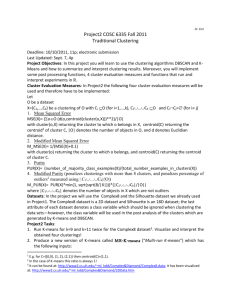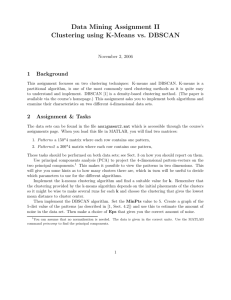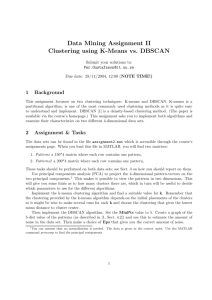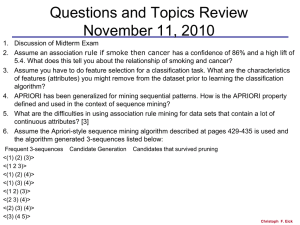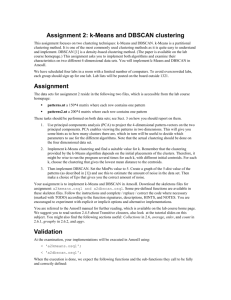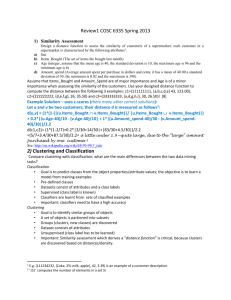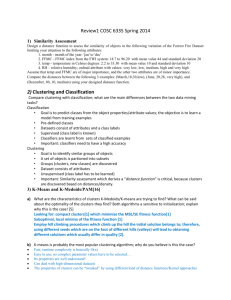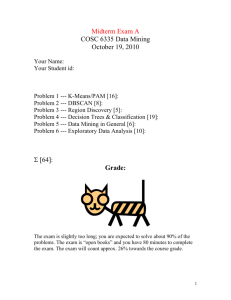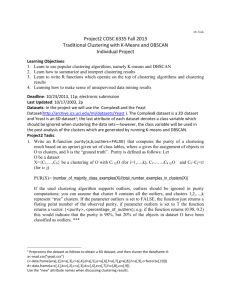Traditional Clustering with K
advertisement
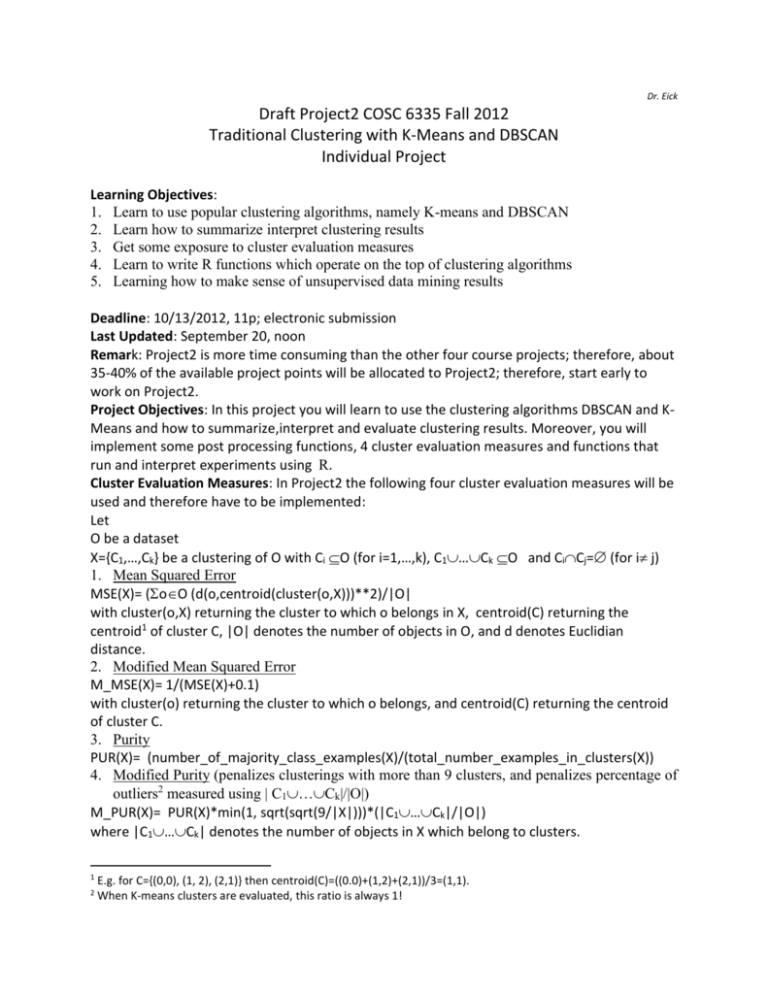
Dr. Eick
Draft Project2 COSC 6335 Fall 2012
Traditional Clustering with K-Means and DBSCAN
Individual Project
Learning Objectives:
1. Learn to use popular clustering algorithms, namely K-means and DBSCAN
2. Learn how to summarize interpret clustering results
3. Get some exposure to cluster evaluation measures
4. Learn to write R functions which operate on the top of clustering algorithms
5. Learning how to make sense of unsupervised data mining results
Deadline: 10/13/2012, 11p; electronic submission
Last Updated: September 20, noon
Remark: Project2 is more time consuming than the other four course projects; therefore, about
35-40% of the available project points will be allocated to Project2; therefore, start early to
work on Project2.
Project Objectives: In this project you will learn to use the clustering algorithms DBSCAN and KMeans and how to summarize,interpret and evaluate clustering results. Moreover, you will
implement some post processing functions, 4 cluster evaluation measures and functions that
run and interpret experiments using R.
Cluster Evaluation Measures: In Project2 the following four cluster evaluation measures will be
used and therefore have to be implemented:
Let
O be a dataset
X={C1,…,Ck} be a clustering of O with CiO (for i=1,…,k), C1…CkO and CiCj= (for i j)
1. Mean Squared Error
MSE(X)= (oO (d(o,centroid(cluster(o,X)))**2)/|O|
with cluster(o,X) returning the cluster to which o belongs in X, centroid(C) returning the
centroid1 of cluster C, |O| denotes the number of objects in O, and d denotes Euclidian
distance.
2. Modified Mean Squared Error
M_MSE(X)= 1/(MSE(X)+0.1)
with cluster(o) returning the cluster to which o belongs, and centroid(C) returning the centroid
of cluster C.
3. Purity
PUR(X)= (number_of_majority_class_examples(X)/(total_number_examples_in_clusters(X))
4. Modified Purity (penalizes clusterings with more than 9 clusters, and penalizes percentage of
outliers2 measured using | C1…Ck|/|O|)
M_PUR(X)= PUR(X)*min(1, sqrt(sqrt(9/|X|)))*(|C1…Ck|/|O|)
where |C1…Ck| denotes the number of objects in X which belong to clusters.
1
2
E.g. for C={(0,0), (1, 2), (2,1)} then centroid(C)=((0.0)+(1,2)+(2,1))/3=(1,1).
When K-means clusters are evaluated, this ratio is always 1!
Datasets: In the project we will use the Complex9 and the Red Wine Evaluation dataset we
already used in Project1. The Complex9 dataset is a 2D dataset and Red Wine Evaluation is an
11D dataset; the last attribute of each dataset denotes a class variable which should be ignored
when clustering the data sets—however, the class variable will be used in the post analysis of
the clusters which are generated by K-means and DBSCAN.
Project2 Tasks:
1. Run K-means for k=9 and k=11 twice for the Complex9 dataset3. Visualize and interpret the
obtained four clusterings!
2. Produce a new version of K-means called Multi-K-means (“Multi-K-means”) which has the
following inputs:
The number of clusters k (same as K-means)
A random number “seed” s (has the same type as the K-means seed)
A cluster evaluation measure eval (1, 2, 3 or 4 referring to the four clustering
evaluation measure introduced earlier)
Multi-K-means runs K-means for k-2,k-1,k(twice—use seed+1 for generating the second
clustering),k+1,k+2 (with the given seed) obtaining clusterings X1,…,X6 returning the
clustering Xi with the highest value for eval(Xi) as well as the maximum,
average, minimum value, and standard deviation of eval(X1),…,eval(X6).
3. Run Multi-K-means with k=9 for the Red Wine Quality4 dataset with the following three
evaluation measures:
M_MSE(X)
PUR(X)
M_PUR(X)
Report the output, and summarize and interpret the results obtainted in the three runs
of Multi-K-means!
4. Run DBSCAN for the Complex9 dataset for MinPoints=6 and for 3 different values for —try
to choose values for which lead to generating different clusters (e.g. having a different
number of clusters and/or outliers). Report M_MSE(X), PUR(X), M_PUR(X) for the 3
clustering results. Visualize and interpret the obtained results! Also compare the clusters
obtained with those obtained using K-means.
5. Run DBSCAN for the Red Wine Quality dataset with a parameter settings which generates
between 3 and 15 clusters5 and the clustering should contain at most 20% outliers. Any
clustering Y you obtain which satisfies the two constraints is fine. Report M_MSE(Y), PUR(Y),
M_PUR(Y) for Y. Next, summarize the obtained DBSCAN clustering Y and compare its
clusters with those generated by K-means in Task3.
3
It can be found at: http://www2.cs.uh.edu/~ml_kdd/Complex&Diamond/Complex9.txt; it has been visualized at:
http://www2.cs.uh.edu/~ml_kdd/Complex&Diamond/2DData.htm
4
Only the first 11 attributes should be used when creating clusterings; the last attribute is only used for cluster
evaluation purposes; e.g. to compute purity.
5
Preferably close to 9 so that K-means and DBSCAN clustering results can be compared more easily—but this
might not be feasible!
Deliverables for Project2:
A. A Report6 which contains all deliverables for the five tasks of Project2.
B. A README file which describes how to run the MR-K-means program, and meta information
for other source code you delivered.
C. Other files which contain the source code of MR-K-means and other software you wrote as
part of this project.
Grund Truth Complex9 Dataset (on the right)
6
Single-spaced; please use a 11-point or 12-point font!
